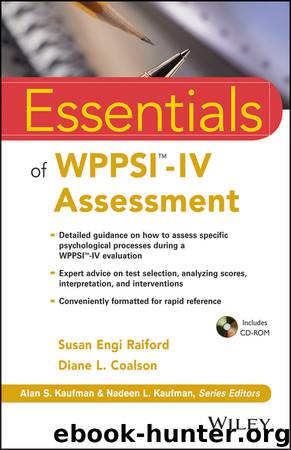Essentials of WPPSI-IV Assessment by Raiford Susan Engi Coalson Diane L. & Diane L. Coalson

Author:Raiford, Susan Engi, Coalson, Diane L. & Diane L. Coalson [Raiford, Susan Engi & Coalson, Diane L.]
Language: eng
Format: epub
ISBN: 9781118380628
Publisher: Wiley
Published: 2014-05-19T00:00:00+00:00
Step 3a. Select the Index Scores (Specific Composite Scores)
We strongly recommend reporting all available primary index scores, because they are derived based on the factor analysis that specifies the latent traits measured by the test. A vast array of other evidence supports their validity and clinical utility. They permit description of discrete cognitive abilities that cannot be differentiated by reporting a global composite score.
Primary index score interpretation is shaped by your theoretical orientation. The descriptions of the primary index scores that appear in previous sections of this chapter facilitate conceptualization of performance from the perspective of CHC, Lurian, or school neuropsychology perspectives. For example, if your theoretical orientation is CHC theory, you might describe the Visual Spatial Index as a measure of Gf, especially visualization and closure speed, but if you are using a neuropsychological approach, you may conceptualize it as measuring neuropsychological constructs including visual–motor construction, problem solving, cognitive flexibility, reasoning, and planning.
Your theoretical orientation may also support the use of some of the additional index scores in this book and on the accompanying CD. For example, if you conceptualize performance using CHC theory, you may wish to administer the additional index scores described in prior sections of this chapter that provide measures of the CHC constructs.
Finally, the referral question and clinical situation may call for use of other index scores. For example, if you are using the WPPSI-IV within a battery to establish the presence of a language disorder in a child with low cognitive ability, you may wish to administer the subtests necessary to obtain the Vocabulary Acquisition Index to obtain a measure of verbal ability with fewer expressive requirements than those of the Verbal Comprehension Index. The Complex Expressive Index may also be of interest in this situation, to provide a measure of verbal ability with comparably greater expressive requirements so that a continuum of index scores involving verbal ability can be examined. All selected index scores are reported and described in Step 3b.
Download
This site does not store any files on its server. We only index and link to content provided by other sites. Please contact the content providers to delete copyright contents if any and email us, we'll remove relevant links or contents immediately.
Rewire Your Anxious Brain by Catherine M. Pittman(18471)
Talking to Strangers by Malcolm Gladwell(13114)
The Art of Thinking Clearly by Rolf Dobelli(10119)
Mindhunter: Inside the FBI's Elite Serial Crime Unit by John E. Douglas & Mark Olshaker(9084)
Becoming Supernatural by Dr. Joe Dispenza(8022)
Change Your Questions, Change Your Life by Marilee Adams(7546)
The Road Less Traveled by M. Scott Peck(7460)
Nudge - Improving Decisions about Health, Wealth, and Happiness by Thaler Sunstein(7443)
The Lost Art of Listening by Michael P. Nichols(7347)
Mastermind: How to Think Like Sherlock Holmes by Maria Konnikova(7136)
Enlightenment Now: The Case for Reason, Science, Humanism, and Progress by Steven Pinker(7076)
Win Bigly by Scott Adams(7022)
The Way of Zen by Alan W. Watts(6437)
Daring Greatly by Brene Brown(6356)
Big Magic: Creative Living Beyond Fear by Elizabeth Gilbert(5541)
Grit by Angela Duckworth(5438)
Ego Is the Enemy by Ryan Holiday(5211)
Men In Love by Nancy Friday(5095)
Altered Sensations by David Pantalony(4991)
